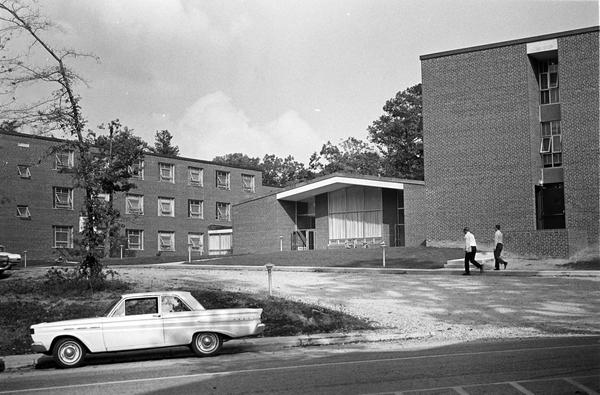On July 1, 1963, the North Carolina State Legislature officially renamed Woman’s College to The University of North Carolina at Greensboro, and the decision was made that all UNC system schools would now be co-educational. But male undergraduates did not immediately arrive on the Greensboro campus. Instead, it was not until the following Fall that the first male undergraduates began their studies. With the start of instruction on September 17, 1964, the UNCG undergraduate student body officially included 282 men.
The decision to transition from a single-sex institution to co-educational was met with mixed reactions on campus. Students were divided on the issue; they formed Pink and Blue factions, and took turns painting the McIver statue and decorating the campus in these colors to show their support of or opposition to coeducation. The Carolinian student newspaper reported the division and ultimately supported the change. Some faculty feared that women would gradually be eliminated from the faculty or reduced to low-level positions teaching introductory courses only.
Campus administrators, however, favored the change, with most of them viewing coeducation as inevitable. With over 2,000 woman already enrolled at UNC Chapel Hill and North Carolina State building its first women’s dormitory, administrators in Greensboro saw their monopoly over female students in the state eroding. Some also hoped that being coeducational (along with having university status) would bring more equitable appropriations from legislators and the UNC system.
When the male students arrived on campus, many faced challenges with both faculty and fellow students who were not in favor of coeducation. When the town students first elected a male representative to student government, some of the female representatives walked out when he spoke and repeatedly voted down any motions he offered. In a 1991 oral history interview, Charles Cole (class of 1969) recalls professors repeatedly entering classes with the greeting, “Hello, ladies,” essentially ignoring the males’ presence. In fact, Cole, an African-American man, found his identity as a male a greater challenge at UNCG than his identity as an African American.
Other challenges were even more basic to student life. The first few male students who didn’t live at home had to find rooms or apartments off campus. Several occupied a converted firehouse at Mendenhall and Walker, a block from campus, that was billed as the “first men’s dorm.” From 1965 to 1967, men were housed in three small apartment buildings adjacent to campus (but owned by the university). No on-campus dormitory housing was offered for male students until Phillips Residence Hall was completed in 1967 (the adjacent Hawkins Residence Hall was occupied by female students).
A 1966 Alumni News article quoted Michael Dean Daniels (class of 1968) discussing a whole different problem. “I have opened a door for a girl, only to stand for five minutes while fifty or sixty girls stream through,” said Daniels. “Each one usually expresses a word of thanks, but these words don’t help much when I try to tell my English professor that I was late to class because I was held up by a doorknob.”
1967 actually saw a number of changes for the male students at UNCG. In addition to the construction of Phillips dormitory, UNCG officially began its first venture in men’s intercollegiate athletics. Athletic Coordinator Frank Pleasants hired three new “instructor-coaches” to “guide the school through its first season of competition.” James R. Swiggett was hired to coach basketball and golf, John Douglas directed wrestling and tennis, and William L. Russell, Jr. was named director of volleyball and intramural events. In addition, Douglas and Russell shared responsibility for cross country competition.
The following years saw male undergraduates move into many of the high-profile student organization positions at UNCG. Lindsay Lamson became the first male Student Government Association president in 1969-1970. Jack Pinnix was the first male editor of the Carolinian in 1968-1969. And by 1973, according to an article in the Alumni News, “the presence of a number of male senators and representatives at Student Legislature meetings has become quite commonplace.”
The same 1973 Alumni News article, written by David B. McDonald (class of 1971), concludes that “there is hardly any aspect of University life that has not been affected by the presence of men on campus … The male entering this University today can be assured not only of receiving a superb education but also of having opportunities for full participation in sports and other extra-curricular activities, and for a most interesting social life.” From 282 in 1964 (6.6% of the total student body) to 3,217 in 1980 (31% of the total student body), the undergraduate male enrollment saw steady growth — even with a rocky start — through the first 15 years of coeducation.
Article by Erin Lawrimore


